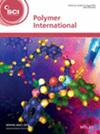求助PDF
{"title":"主链发光聚苯并恶嗪的无催化剂合成、表征及光致发光","authors":"Kamal I Aly, Aya Khamies, Osama Younis","doi":"10.1002/pi.6753","DOIUrl":null,"url":null,"abstract":"<p>Two novel luminescent main-chain polybenzoxazine polymers, (Poly1)<sub>main</sub> and (Poly2)<sup>x</sup><sub>main</sub>, were synthesized and characterized to explore their structural, thermal, morphological and photophysical properties. Polymer (Poly1)<sub>main</sub> was obtained via a Mannich condensation reaction without a catalyst, followed by thermal polymerization to produce the crosslinked polymer (Poly2)<sup>x</sup><sub>main</sub>. Structural analyses using Fourier transform infrared spectroscopy and X-ray diffraction confirmed the successful formation of the polymers, with (Poly2)<sup>x</sup><sub>main</sub> exhibiting a higher degree of crosslinking and partial ordering in an otherwise amorphous structure. Scanning electron microscopy imaging revealed that thermal polymerization significantly altered the morphology, transforming the porous structure of (Poly1)<sub>main</sub> into a denser, layered morphology in (Poly2)<sup>x</sup><sub>main</sub>. Thermogravimetric analysis and differential scanning calorimetry highlighted the improved thermal stability of (Poly2)<sup>x</sup><sub>main</sub> due to extensive crosslinking. Photophysical studies showed that (Poly1)<sub>main</sub> in solution exhibited yellow-green luminescence with a broad emission maximum at 522 nm and CIE coordinates (0.39, 0.48). In contrast, the powders of both polymers displayed sharp red luminescence with an emission peak at 658 nm and CIE coordinates (0.72, 0.27), attributed to molecular packing effects and exciton coupling in the solid state. These results underscore the interplay among structural, morphological and photophysical properties, highlighting the potential of these polymers in optoelectronics, sensing and luminescent materials. © 2025 Society of Chemical Industry.</p>","PeriodicalId":20404,"journal":{"name":"Polymer International","volume":"74 7","pages":"602-610"},"PeriodicalIF":3.6000,"publicationDate":"2025-03-03","publicationTypes":"Journal Article","fieldsOfStudy":null,"isOpenAccess":false,"openAccessPdf":"","citationCount":"0","resultStr":"{\"title\":\"Catalyst-free synthesis, characterization and photoluminescence of main-chain luminescent polybenzoxazines\",\"authors\":\"Kamal I Aly, Aya Khamies, Osama Younis\",\"doi\":\"10.1002/pi.6753\",\"DOIUrl\":null,\"url\":null,\"abstract\":\"<p>Two novel luminescent main-chain polybenzoxazine polymers, (Poly1)<sub>main</sub> and (Poly2)<sup>x</sup><sub>main</sub>, were synthesized and characterized to explore their structural, thermal, morphological and photophysical properties. Polymer (Poly1)<sub>main</sub> was obtained via a Mannich condensation reaction without a catalyst, followed by thermal polymerization to produce the crosslinked polymer (Poly2)<sup>x</sup><sub>main</sub>. Structural analyses using Fourier transform infrared spectroscopy and X-ray diffraction confirmed the successful formation of the polymers, with (Poly2)<sup>x</sup><sub>main</sub> exhibiting a higher degree of crosslinking and partial ordering in an otherwise amorphous structure. Scanning electron microscopy imaging revealed that thermal polymerization significantly altered the morphology, transforming the porous structure of (Poly1)<sub>main</sub> into a denser, layered morphology in (Poly2)<sup>x</sup><sub>main</sub>. Thermogravimetric analysis and differential scanning calorimetry highlighted the improved thermal stability of (Poly2)<sup>x</sup><sub>main</sub> due to extensive crosslinking. Photophysical studies showed that (Poly1)<sub>main</sub> in solution exhibited yellow-green luminescence with a broad emission maximum at 522 nm and CIE coordinates (0.39, 0.48). In contrast, the powders of both polymers displayed sharp red luminescence with an emission peak at 658 nm and CIE coordinates (0.72, 0.27), attributed to molecular packing effects and exciton coupling in the solid state. These results underscore the interplay among structural, morphological and photophysical properties, highlighting the potential of these polymers in optoelectronics, sensing and luminescent materials. © 2025 Society of Chemical Industry.</p>\",\"PeriodicalId\":20404,\"journal\":{\"name\":\"Polymer International\",\"volume\":\"74 7\",\"pages\":\"602-610\"},\"PeriodicalIF\":3.6000,\"publicationDate\":\"2025-03-03\",\"publicationTypes\":\"Journal Article\",\"fieldsOfStudy\":null,\"isOpenAccess\":false,\"openAccessPdf\":\"\",\"citationCount\":\"0\",\"resultStr\":null,\"platform\":\"Semanticscholar\",\"paperid\":null,\"PeriodicalName\":\"Polymer International\",\"FirstCategoryId\":\"92\",\"ListUrlMain\":\"https://scijournals.onlinelibrary.wiley.com/doi/10.1002/pi.6753\",\"RegionNum\":4,\"RegionCategory\":\"化学\",\"ArticlePicture\":[],\"TitleCN\":null,\"AbstractTextCN\":null,\"PMCID\":null,\"EPubDate\":\"\",\"PubModel\":\"\",\"JCR\":\"Q2\",\"JCRName\":\"POLYMER SCIENCE\",\"Score\":null,\"Total\":0}","platform":"Semanticscholar","paperid":null,"PeriodicalName":"Polymer International","FirstCategoryId":"92","ListUrlMain":"https://scijournals.onlinelibrary.wiley.com/doi/10.1002/pi.6753","RegionNum":4,"RegionCategory":"化学","ArticlePicture":[],"TitleCN":null,"AbstractTextCN":null,"PMCID":null,"EPubDate":"","PubModel":"","JCR":"Q2","JCRName":"POLYMER SCIENCE","Score":null,"Total":0}
引用次数: 0
引用
批量引用




 求助内容:
求助内容: 应助结果提醒方式:
应助结果提醒方式:


